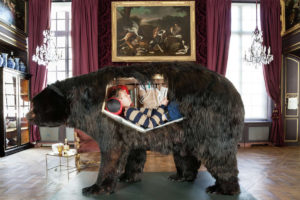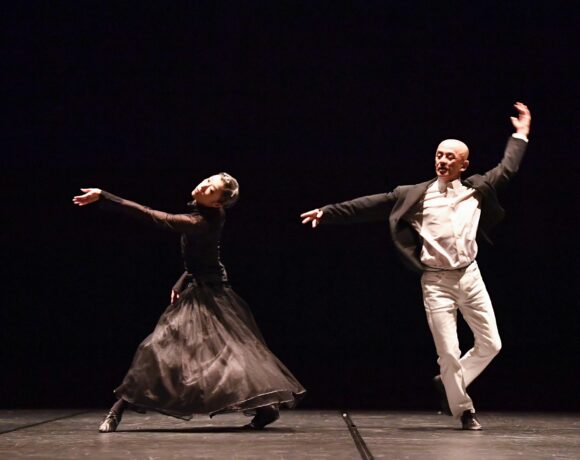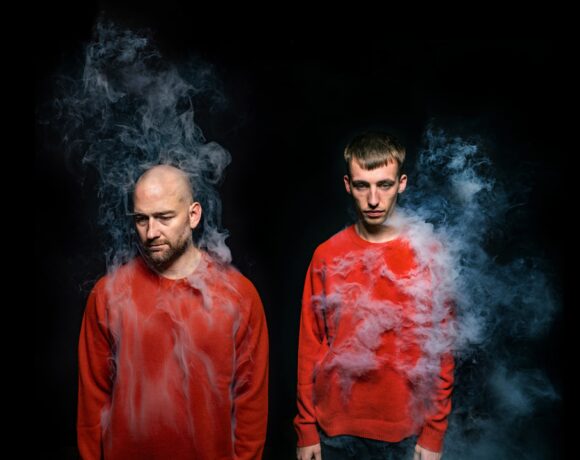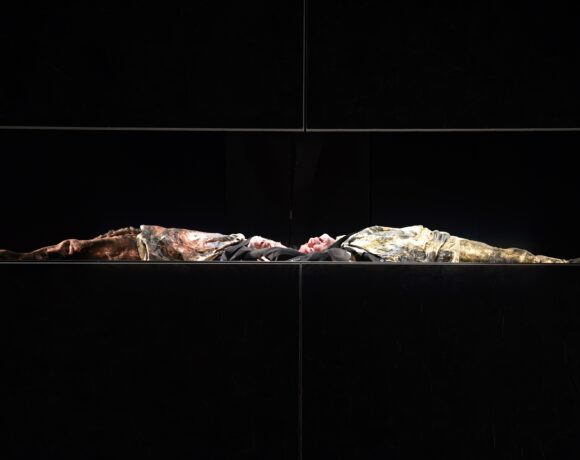The undeniably fundamental talent is not enough to make an artist. It is indeed necessary that this be accompanied by human qualities whose maintenance and development can only be ensured by constant commitment. The ability and courage to operate an introspection that leads to the knowledge of one’s own essence and limits, is the prerogative of those who know how to make art a tool of teaching that awakens consciences and encourages change. Abraham Poincheval is one of them.
This article proposes a journey inside the mind of a man who has made his ability to live isolation a resource. Born in 1972, the French Abraham Poincheval tried everything, so much so that he was nicknamed the “extreme performer”. Buried in a sewer under the square of the commune of Tours, enclosed in a stuffed bear for 13 days at the Hunting Museum in Paris, transported by the Rhone current in a 6-meter bottle, sitting for 6 days on a platform over 20 meters from the ground at the Gare de Lyon in Paris, and still present at the Tokyo Palace hatching eggs for three weeks in a giant format incubator or confined within a rock listening to the secrets that visitors came to whisper to him… These surreal performances are the result of questions that arise very soon in the mind of Abraham Poincheval, who already as a student wonders about what art is and how to create a work, and which will lead him into adulthood to “live in the works, more than in society” as he says.
Far from considering himself a hermit, Abraham Poincheval specifies that he is a sociable person who, like everyone else, loves company. It would therefore be wrong to believe that his long experience in the field of extreme adventures gives him a sort of immunity to the sense of loneliness or fear that can arise in each of us when we face a situation that puts us to the test. Mastering time, without the slightest point of reference that is even knowing if you are during the day or night, maintaining the same position during sleep and awake, overcoming fear and facing loneliness, these are the challenges to which Abraham Poincheval undergoes every time he realizes a new project. For his performances, an accurate physical and mental preparation is necessary, which allows the artist to train his will to get involved and to see the difficulty as an excellent opportunity for growth.
The artist does not hide that he had moments of anguish that he controlled thanks to the breathing exercises, letting his consciousness derive but keeping it under control. “You can indulge in escapades,” he says, “but you must always keep a thread of Ariadne that can be rewound in thoughts.”
In this context, the notion of boredom also re-emerges, which according to the artist is beneficial before a project since it is a time when the mind rests and in the absence of interpretations, ideas can arise freely. Once in isolation, however, Abraham Poincheval specifies that there is no more room for boredom since it is extremely important for him to remain concentrated so as not to succumb to the fragile situation in which he finds himself. In addition to the mental side, in fact, even the physical can suffer the consequences of a greater stall, especially if you are confined in a small space. It follows the importance of constantly practicing physical movement even if limited as in his case.
These experiences of solitude have allowed the artist to develop a more acute perception, for this reason he considers that having completed the necessary learning process, isolation “can be an opportunity to give up perpetual movement”. Ultimately Abraham Poincheval reveals to us a truth that we should never forget “that the human being is a territory no less immense than the outside world”.
His testimony, already important in itself, takes on an even stronger meaning in the current context in which confinement at home for each of us proves necessary to stop the propagation of Covid-19.
The artist believes that isolation involves three stages, the first of which is the adaptation to a new rhythm of life which particularly implies focusing on the present, which is not easy since usually we always run after we don’t know well what and we focus more on a future that never comes. In this first phase, new reference points are sought and new habits are established. In a second moment we rediscover ourselves and we begin to reflect on what is really important for us. The last stage is the one that coincides with the end of isolation and is a kind of proof of the truth as it allows us to test our tenacity and that is to understand if we have learned a lesson from the isolation situation in which we lived. Joan Mirò expresses it so well when he says that “what matters is not a work but the trajectory of the spirit throughout one’s life”.
Ilaria Greta De Santis
Info:
 Abraham Poincheval, Ours, 2014. Mixed media 160 × 220 × 110 cm Photo : Sophie Lloyd Courtesy Semiose, Paris
Abraham Poincheval, Ours, 2014. Mixed media 160 × 220 × 110 cm Photo : Sophie Lloyd Courtesy Semiose, Paris
 Abraham Poincheval, Oeuf, 2017. Hen’s eggs, blanket by Seulgl Lee and various materials Photo : A. Mole Courtesy Semiose, Paris
Abraham Poincheval, Oeuf, 2017. Hen’s eggs, blanket by Seulgl Lee and various materials Photo : A. Mole Courtesy Semiose, Paris
 Abraham Poincheval, Walk on Clouds, 2020. Silver print, lightbox 87 × 240 cm Photo : A. Mole Courtesy Semiose, Paris
Abraham Poincheval, Walk on Clouds, 2020. Silver print, lightbox 87 × 240 cm Photo : A. Mole Courtesy Semiose, Paris

Paraphrasing Fellini, I will tell you that I am an oyster and my path is a grain of sand that is turning into a pearl. From law degree to art history degree at the Sorbonne in Paris. From the French capital I tell you about art.






NO COMMENT